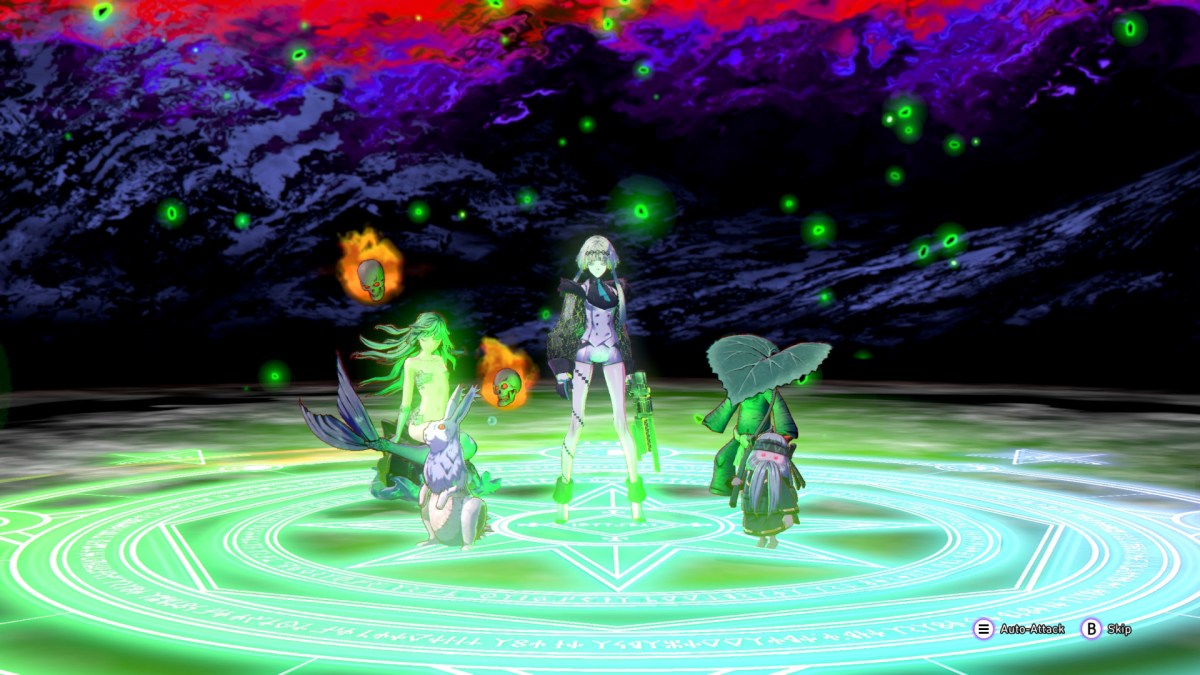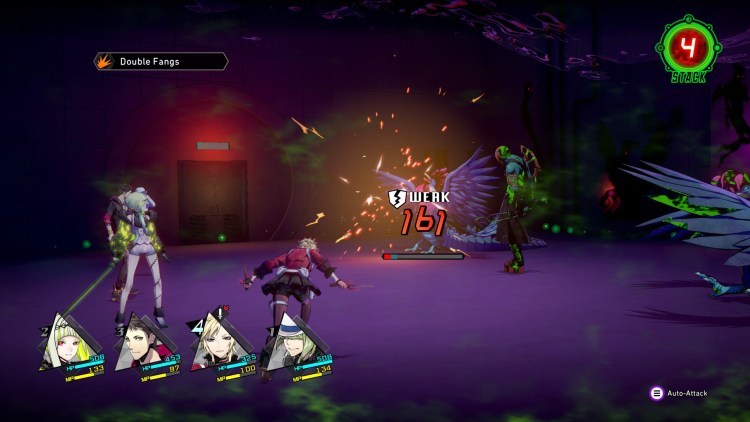I used to love turn-based RPGs. However, as I got older, I started to find them more and more boring. Most of them feel incredibly interchangeable to me, to the point that I often didn’t feel like they had gameplay as much as a bunch of mostly identical experiences with different coats of paint. That is, barring anything with the Shin Megami Tensei name attached to it. The series has always been fun to me, as I’ve long loved the careful balancing of weakness exploitation, demon fusing, and proper utilization of buffs. Soul Hackers 2 has all of that in spades, along with its own wrinkles and a truly impressive amount of features that let you fuse this demon with a lot of useful tricks.
Soul Hackers 2 is obviously not a Persona game, so you shouldn’t expect characters to talk at each other for hours on end or focus on an extremely lengthy plot. The story here is serviceable and the characters are likable enough, but it won’t blow anyone’s socks off. Iron Mask, the head of Phantom Society, a group of Devil Summoners hellbent on summoning a god to destroy and remake the world, is after five multi-colored MacGuffins called Covenants that will allow him to summon the aforementioned god.
Not so Persona-fied
Predicting the impending destruction of the world due to this, the sentient information network Aion uses bits of its data to create the twins Ringo and Figue before sending them out into the world to stop Iron Mask. You play as Ringo as she puts together a team to stop this all from going down. Soul Hackers 2 takes place in the same continuity as the other Devil Summoner games, but you don’t need to be familiar with them. Although there are some references that won’t mean much to you otherwise.
The plot is fine, but it lacks detail and there isn’t much worldbuilding to speak of. Dialogue and characterization are respectable. However, some story events make no sense, character decisions can be baffling, and much of the terminology seems tossed off. Granted, this is pretty standard for the genre, but if you go in here expecting Persona-caliber writing you’ll be disappointed.
Fusion frenzy
The game lets you move freely by picking locations from a map. There are a few shopping districts with businesses that are necessary for your team’s continued growth. You’ll also access a safehouse and travel to the game’s dungeons (if you can call them that). While not in one of those, you can freely open up the map and fast travel to any points of interest, including going directly to the front door of Soul Hackers 2‘s establishments.
Ringo’s party consists of her and three other Summoners. Things function like a combination between mainline SMT and Persona games. While you can purchase accessories that beef up each character’s defense, the majority of their movesets are based solely on which demon they have equipped. All characters can equip any demon you have with you, which basically makes every character like a Persona protagonist.
Due to this, there’s a large amount of freedom when it comes to how you outfit your party. Demon fusing seems rigid at first, but it’s important to use the fusion search function instead of just choosing the ones you have directly available. But it’s not as easy as it sounds, as many demons won’t learn skills that aren’t in their wheelhouse.
Demons join you after being scouted in the field by the demons already in your party. You don’t attempt to bribe the ones you face in battle, which I strongly appreciated. This does add a greater element of RNG than before, however, as you’ll have to fuse a specific demon if it isn’t just dropped in your lap.
Let’s do some recon
One area that Soul Hackers 2 is noticeably lacking in is environmental variation. The first place you go is basically a cargo dock by the water, which is quite small. Then you hit up two drab, nondescript subway lines. The game’s environments are sadly a little boring.
Then there’s the Soul Matrix. Each of Ringo’s compatriots is mentally joined with her and has a multi-floor labyrinth that can be used to see some of their memories. It’s here that they’ll learn passive or active skills that can seriously enhance your combat capabilities.
But the problem is that the areas in the Soul Matrix are all voids filled with blue cubes. Remember how monotonous the floors of Tartarus were in Persona 3? The Soul Matrix is significantly less visually interesting than even those. That being said, the level design in them doesn’t suffer the same fate. Just like the main dungeon areas, you’ll have to contend with some gimmicks that have a puzzle-nature. There’s nothing here as elaborate as the palaces in Persona 5, but the areas are more like what you’d see in a mainline SMT game. Enemy encounters are based around making contact with foes in the field. But Ringo can knock most of them down with a sword slash, meaning you’ll only be fighting exactly as much as you wish to.
Combat is, of course, a particularly noteworthy aspect of Soul Hackers 2. Each demon can only have four skills at first. The set of skills expands as you increase your comrades’ soul levels, which you’ll raise by choosing certain answers during dialogue sequences or by interacting with them during hangout events at a bar. The higher their soul level, the deeper you’ll be able to progress in their section of the Soul Matrix. Soul Hackers 2 feels remarkably fleshed out in regards to how all of its systems tie together and encourage you to partake in the various pieces of content on offer.
Weak in the knees
In place of the all-out attack system from the Persona games are Sabbaths. If you hit an enemy demon with one of their weaknesses, you gain numbers in a stack. At the end of each turn where you have a stack in play, the demons that were used to trigger said weaknesses will attack all of your foes at once. The higher the stack number, the more damage you do. It’s a highly enjoyable system that rewards strategy. It’s tied together when using commander skills, which allow you to swap out demons during battle or significantly strengthen your Sabbaths every few turns.
I could go on at length about how much deeper everything in Soul Hackers 2 goes, from equipping Mistiques to increase the amount of damage certain skills do or how much MP they cost, to carefully synergizing your team. Enemies also drop items that can be used to purchase a myriad of improvements. There’s a compelling amount of depth here, which makes the game quite engaging. I continually found myself looking forward to the next round of improvements, as they often have very tangible effects on your battle strength.
Soul Hackers 2 may not impress with its sometimes redundant environmental design and the story doesn’t stand on its own by any means. But the gameplay is as intricate and rewarding as a turn-based RPG could hope to be, making it all too easy to sink hour after hour into honing your battle effectiveness or routinely fusing new demons with skillsets that are just right. The game does a remarkable job of incentivizing you to frequently switch up your demons. It’s more than enough to keep players hungry for more as they dismantle their foes with yet another Sabbath before going and dropping a ton of money on a plethora of upgrades. All of that and more make the game more than worthy of the Shin Megami Tensei name.












Published: Aug 18, 2022 10:00 am